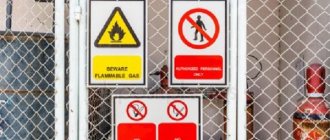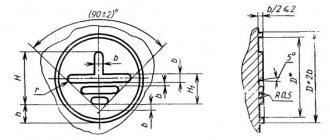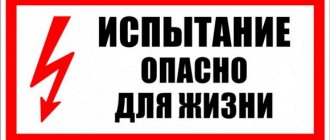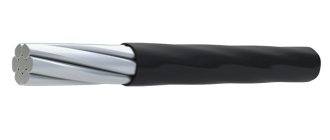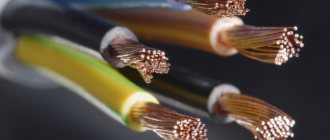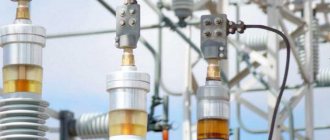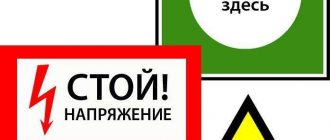3.5. Locking Requirements
3.5.1. When performing blocking, the possibility of its false operation must be excluded.
3.5.2. Locking of products intended for installation in rooms, the entrances to which are not equipped, in turn, with locking, and having holding electromagnets or charged springs, must be carried out in such a way as to eliminate the danger associated with the movement of parts of the product due to accidental removing or applying voltage to the control circuit.
3.5.3. By agreement with the consumer, instead of interlocks, the design of which significantly complicates the maintenance of electrical products, other measures may be used to ensure the safety of their maintenance.
(Introduced additionally, Amendment No. 3).
3.8. Requirements for warning signs, signs and signs
3.8.1. The alarm must be made by light or sound.
Light signaling can be carried out using either continuously burning or flashing lights.
3.8.2. The following colors must be used for light signals:
red - for prohibiting and alarm signals, as well as for warning about overloads, incorrect actions, danger and a condition requiring immediate intervention (in case of fire, etc.);
yellow - to attract attention (warnings about reaching limit values, about switching to automatic operation, etc.);
green - for safety signaling (normal operating mode of the product, permission to start operation, etc.);
white - to indicate the on state of the switch, when the use of red, yellow and green colors is irrational;
blue - for use in special cases when red, yellow, green and white cannot be used.
3.8.3. Signal lamps and other light-signaling devices must have signs or inscriptions indicating the meaning of the signals (for example, “On”, “Off”, “Heating”).
3.6. Shell requirements
3.6.1. Shells must be connected to the main parts of the products into a single structure, cover the hazardous area and be removed only with the help of a tool.
It is not allowed that the screws (bolts) for fastening live and moving parts of the product and for fastening its shell are common.
3.6.2. If necessary, shells must have handles, brackets and other devices for convenient and safe holding during removal or installation. The requirements for these devices and the need for their installation must be specified in the standards and technical specifications for specific types of products.
3.6.3. When opening and closing doors and hatches of the shell, the possibility of them touching (or approaching at an unacceptable distance) the moving parts of the product or live parts must be excluded.
(Changed edition, Amendment No. 1).
3.6.4. The degree of protection against contact with live and moving parts using shells must comply with GOST 14254-80 and be specified in the standards and technical specifications for specific types of products.
3.6.5. Shells in normal and emergency operating modes must retain their protective properties.
3.6.6. The shell of products containing contact connections should not be made of thermoplastic materials.
3.7. Requirements for terminals and input devices
3.7.1. Wires should be inserted into housings, terminal boxes, shields and other devices through insulating parts. In this case, the possibility of damage to the wires and their insulation during installation and operation of the product must be excluded.
Multi-core wires must be prevented from splitting into individual wires.
When using braided wires, it must be prevented from unraveling.
3.7.2. The design and material of input devices must exclude the possibility of accidental contact with live parts, electrical overlaps, as well as short-circuiting of conductors to the housing and short-circuiting.
3.7.3. Sufficient space must be provided inside the input device for safe access to its elements (contacts, conductors, clamps, etc.) and for inserting and cutting wires.
3.7.4. Screw contact connections should not be sources of ignition in the “bad” contact mode.
CLASSES OF ELECTRICAL PRODUCTS BY METHOD OF PROTECTING PERSONS FROM ELECTRIC SHOCK
2.1. Five protection classes are established: 0, 0I, I, II, III.
Class 0 must include products that have at least functional insulation and no grounding elements, unless these products are classified in class I or III.
Class 0I must include products that have at least working insulation, an element for grounding and a wire without a grounding conductor for connection to the power source.
Class I must include products that have at least functional insulation and a grounding element. If a Class I product has a cord for connection to a power source, that cord must have a grounding conductor and a grounding pin plug.
Class II should include products that have double or reinforced insulation and do not have elements for grounding.
Class III should include products designed to operate at safe extra-low voltage, having neither external nor internal electrical circuits operating at a different voltage.
Externally powered products can only be classified as Class III if they are connected directly to a power source that converts the higher voltage to safety extra-low voltage, either by means of an isolating transformer or converter with separate windings.
When using an isolation transformer or converter as a power source, its input and output windings must not be electrically connected and there must be double or reinforced insulation between them.
1. GENERAL PROVISIONS
1.1 Electrical products must comply with the requirements of this standard, GOST 12.1.019-79, GOST 12.1.004-85, and products used as production equipment must also meet the requirements of GOST 12.2.003-74.
1.2. The following can be used in electrical products:
insulation of live parts (working, additional, double, reinforced);
safe extra-low voltage in electrical circuits;
elements for carrying out protective grounding of metal non-current-carrying parts of the product that may be energized (in the event of a violation of insulation, operating mode of the product, etc.);
elements that disconnect the product from the network when parts of the product accessible to touch are energized, including lightning discharges;
shells to prevent the possibility of accidental contact with live, moving, heated parts of the product;
locks to prevent erroneous actions and operations;
screens and other means of protection from the dangerous and harmful effects of electromagnetic fields, thermal, optical and x-ray radiation, as well as from induction currents and static electricity;
means for removing hazardous and harmful substances generated during operation;
elements designed to monitor insulation and signal its damage, as well as to turn off the product when the insulation resistance decreases below the permissible level;
warning notices, signs, painting in signal colors and other means of signaling danger (only in combination with other safety measures);
meeting ergonomic requirements.
Note:Safety Extra Low Voltage is a nominal voltage that does not exceed 42V between individual conductors or between a conductor and ground, with no load voltage not exceeding 50V. In the presence of particularly unfavorable conditions, when the danger of electric shock is aggravated by cramped conditions, uncomfortable position of the worker, contact with large metal well-grounded surfaces (for example, work in boilers, on pontoons), a voltage other than 12V should be used to power hand-held lamps.
1.1, 1.2. (Changed edition, Amendment No. 2).
1.3. Safety requirements not established by this standard must be specified in standards and technical specifications for specific types of products.
3.1. General requirements.
3.1.1. The design of electrical products must include means of noise and vibration protection that ensure noise and vibration levels at workplaces in accordance with approved sanitary standards. Permissible values of noise and vibration characteristics of electrical products must be established in standards and technical specifications for products specific types and should not exceed the values specified in GOST 12.1.003-83, GOST 12.1.012-78.
(Changed edition, Amendment No. 3).
3.1.2. Products that create electromagnetic fields must have protective elements (screens, absorbers, etc.) to limit the impact of these fields in the work area to acceptable levels.
The requirements for these protective elements must be specified in the standards and technical specifications for specific types of products.
To limit exposure to electromagnetic fields, it is allowed to use protective elements that are not part of the product.
3.1.3. Products that are a source of thermal, optical, x-ray radiation, as well as ultrasound, must be equipped with means to limit the intensity of these radiations and ultrasound to permissible values.
Requirements for means limiting the intensity of radiation and ultrasound, as well as the permissible heating temperature of the surface of the outer shell of the product, must be specified in the standards and technical specifications for specific types of products. It is allowed to use protective elements that are not part of the product to limit exposure to radiation.
3.1.4. Requirements for the presence in the design of the product of elements intended to protect against accidental contact with moving, current-carrying, heated parts of the product, and elements for protection from hazardous and harmful construction materials and substances released during operation, as well as the requirements for these protective elements, must be specified in standards and technical specifications for specific types of products.
3.1.5. The electrical circuit of the product must exclude the possibility of its spontaneous switching on and off.
3.1.6. The arrangement and connection of parts of the product must be made taking into account the convenience and safety of observing the product during assembly work, inspection, testing and maintenance.
If necessary, products must be equipped with inspection windows, hatches and local lighting. Requirements for observation windows, hatches and local lighting must be specified in the standards and technical specifications for specific types of products.
3.1.7. The design of the product must exclude the possibility of incorrect connection of its articulated current-carrying parts when installing the products at the consumer. The design of sockets and plugs for voltages above 42 V must be different from the design of sockets and plugs for voltages of 42 V and less.
3.1.8. If necessary, products must be equipped with alarms, inscriptions and signs.
To make a connection using a plug socket, a power source must be connected to the socket, and its receiver must be connected to the plug.
Warning signals, inscriptions and signs should be used to indicate: the switched on state of the product, the presence of voltage, insulation breakdown, operating mode of the product, prohibition of access to the inside of the product without taking appropriate measures, an increase in the temperature of individual parts of the product above permissible values, the operation of protective devices, etc. P.
Signs used when making warning signs and alarms must be made in accordance with GOST 12.4.026-76 and placed on products in places convenient for viewing.
3.1.7, 3.1.8. (Changed edition, Amendment No. 1).
3.1.9. Products and their components weighing more than 20 kg or having large overall dimensions must have devices for lifting, lowering and holding them suspended during installation and rigging work.
The shape, dimensions and load-carrying capacity of lifting devices are in accordance with GOST 4751-73 or GOST 13716-73. It is allowed to use other lifting devices that ensure safe installation and rigging work.
(Changed edition, Amendment No. 3).
3.1.10. Fire safety of the product and its elements must be ensured both in normal and emergency operating modes.
Reducing the fire hazard of electrical products and their parts is achieved by:
with the exception of the use of flammable materials in the design of products in accordance with GOST 12.1.044-84. “Fire safety” of the product and its elements must be ensured in both normal and emergency operating modes (short circuit, overload, poor contact, etc.);
limiting the mass of combustible materials, as well as replacing them with more heat-resistant ones in accordance with GOST 8865-87;
limiting the penetration of flammable materials (substances) from outside to fire hazardous components of electrical products;
using the design of products to prevent the emission of hot and (or) burning particles;
introduction into the design of products and into the installations in which the products are used, means and elements of electrical protection that reduce the likelihood of a fire, in accordance with the standards established by GOST 12.1.004-85;
the predominant use of products with a smaller number of consecutive contact points per pole, which can become the source of poor contact;
bringing the value of transition resistance in contact connections to the level established by the standards for specific products;
excluding the use of products capable of releasing toxic combustion products in quantities that pose a danger to human life and health;
limiting the temperature of possible ignition sources and selecting the operating mode of electrical products that ensure fire and explosion safety conditions for substances and materials in accordance with GOST 12.1.044-84;
the use of means and (or) elements designed to automatically shut down the product in emergency mode (overload, overheating, short circuit, etc.) and to prevent the fire of parts of products made of electrical insulating materials.
(Introduced additionally, Amendment No. 2).
